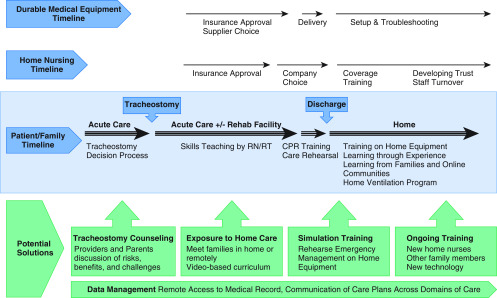Figure 1.
Reconstruction of discharge experience, challenges, and potential solutions. This timeline is constructed from participant interviews representing the transitional experience of families (triple line light blue box) from before tracheostomy to after discharge home. Parallel durable medical equipment (DME) and home nursing timelines are depicted (single lines) that do not optimally align with the family timeline. In particular, delays in approval and filling of nursing hours, as well as the timing of DME delivery just before—or coincident with—discharge contribute to family stress. Green boxes represent opportunities to address barriers to successful transition home, including initial counseling, graded exposure to homecare, approaches to caregiver training, and communication with multiple providers. Improved remote access to the electronic health record (including summary medical history, recent diagnostics, and clear contacts for specific condition and medication questions) for families, home care, and community providers has the potential to decrease information loss and the need for work-arounds. CPR = cardiopulmonary resuscitation; RN = registered nurse; RT = respiratory therapist.

